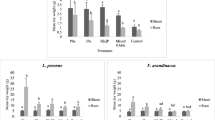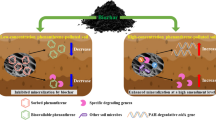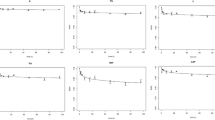Abstract
Rhizodegradation is a technique involving plants that offers interesting potential to enhance biodegradation of persistent organic pollutants such as polycyclic aromatic hydrocarbons (PAHs). Nevertheless, the behaviour of PAHs in plant rhizosphere, including micro-organisms and the physico-chemical soil properties, still needs to be clarified. The present work proposes to study the toxicity and the dissipation of phenanthrene in three artificially contaminated soils (1 g kg-1 DW). Experiments were carried out after 2 months of soil aging. They consisted in using different systems with two plant species (Ryegrass—Lolium perenne L. var. Prana and red clover—Trifolium pratense L. var. fourragère Caillard), three kinds of soils (a silty-clay-loam soil “La Bouzule”, a coarse sandy-loam soil “Chenevières” and a fine sandy-loam soil “Maconcourt”). Phenanthrene was quantified by HPLC in the beginning (T 0) and the end of the experiments (30 days). Plant biomass, microbial communities including mycorrhizal fungi, Rhizobium and PAH degraders were also recorded. Generally phenanthrene contamination did not affect plant biomass. Only the red clover biomass was enhanced in Chenevières and La Bouzule polluted soils. A stimulation of Rhizobium red clover colonisation was quantified in spiked soils whereas a drastic negative phenanthrene effect on the mycorrhization of ryegrass and red clover was recorded. The number of PAH degraders was stimulated by the presence of phenanthrene in all tested soils. Both in ryegrass and red clover planted soils, the highest phenanthrene dissipation due to the rhizosphere was measured in La Bouzule soils. On the contrary, in non-planted soils, La Bouzule soils had also the lowest pollutant dissipation. Thus, in rhizospheric and non-rhizospheric soils the phenanthrene dissipation was found to depend on soil clay content.



Similar content being viewed by others
Abbreviations
- PAHs:
-
Polycyclic aromatic hydrocarbons
References
Amellal N, Portal JM, Berthelin J (2001a) Effect of soil structure on the bioavailability of polycyclic aromatic hydrocarbons within aggregates of a contaminated soil. Appl Geochem 16:1661–1619
Amellal N, Portal JM, Vogel T, Berthelin J (2001b) Distribution and location of polycyclic aromatic hydrocarbons (PAHs) and PAHs degrading bacteria within polluted soil aggregates. Biodegradation 12:49–57
Amellal S, Boivin A, Perrin Ganier C, Schiavon M (2006) High sorption of phenanthrene in agricultural soils. Agron Sustain Dev 26:99–106
Aprill W, Sims RC (1990) Evaluation of the use of prairie grasses for stimulating polycyclic aromatic hydrocarbon treatment in soil. Chemosphere 55:253–265
Binet P, Portal JM, Leyval C (2000a) Fate of polyaromatic hydrocarbons (PAH) in the rhizosphere and mycorrhizosphere of ryegrass. Plant Soil 227:207–213
Binet P, Portal JM, Leyval C (2000b) Dissipation of 3–6 ring polycyclic aromatic hydrocarbons in the rhizosphere of ryegrass. Soil Biol Biochem 32:2011–2017
Binet P, Portal JM, Leyval C (2001) Application of GC-MS to the study of anthracene biodegradation in the rhizosphere of ryegrass. Org Geochem 32:217–222
Bouwer EJ, Zehnder AJB (1992) Bioremediation of organic compounds-putting microbial metabolism to work. Trends Biotechnol 11:360–367
Chaineau CH, Morel JL, Oudot J (1995) Microbial degradation in soil microcosms of fuel oil hydrocarbons from drilling cuttings. Environ Sci Technol 29:1615–1621
Chaineau CH, Morel JL, Oudot J (1997) Phytotoxicity and plant uptake of fuel oil hydrocarbons. J Environ Qual 26:1478–1483
Chung N, Alexander M (2002) Effect of soils properties on bioavailability and extractability of phenanthrene and atrazine sequestred soil. Chemosphere 48:109–115
Corgié SC, Joner E, Leyval C (2003) Rhizospheric degradation of phenanthrene is a function of proximity to roots. Plant Soil 257:143–150
Corgié SC, Beguiristain T, Leyval C (2004) Spatial distribution of bacterial communities and phenanthrene degradation in the rhizosphere of Lolium perenne L. Appl Environ Microbiol 70:3552–3557
Edwards NT (1983) Polycyclic aromatic hydrocarbons (PAH’s) in the terrestrial environment—a review. J Environ Qual 12:427–441
Fang C, Radosevich M, Fuhrman JJ (2001) Atrazine and phenanthrene degradation in grass rhizosphere soil. Soil Biol Biochem 33:671–678
Gao Y, Zhu L, Ling W (2004) Application of the partition-limited model for plant uptake of organic chemicals from soil and water. Sci Total Environ 36:171–182
Günther T, Dornberger U, Fritsche W (1996) Effect of ryegrass on biodegradation of hydrocarbonsin soil. Chemosphere 33:203–215
Hatzinger PB, Alexander M (1995) Effect of aging of chemicals in soil on their biodegradability and extractability. Environ Sci Technol 29:537–545
Henner P, Schiavon M, Druelle V, Lichtfouse E (1999) Phytotoxicity of ancient gaswork soils. Effect of polycyclic aromatic hydrocarbons (PAHs) on plant germination. Org Geochem 30:963–969
Johnson DL, Maguire KL, Anderson DR, McGrath SP (2004) Enhanced dissipation of chrysene in planted soil: the impact of a rhizobial inoculum. Soil Biol Biochem 36:33–38
Joner EJ, Leyval C (2003) Rhizosphere gradients of polycyclic aromatic hydrocarbons (PAH) dissipation in two industrial soils and the impact of arbuscular mycorrhiza. Environ Sci Technol 37:2371–2375
Joner E, Johansen A, De la Cruz MAT, Szolar OJH, Liobner A, Portal JM, Leyval C (2001) Rhizosphere effects on microbial community structure and dissipation and toxicity of polycyclic aromatic hydrocarbons (PAHs) in spiked soil. Environ Sci Technol 35:2773–2777
Joner EJ, Corgié SC, Amellal N, Leyval C (2002) Nutritional constraints to degradation of polycyclic aromatic hydrocarbons in a simulated rhizosphere. Soil Biol Biochem 34:859–864
Karthikeyan R, Kulakow PA (2003) Soil plant interactions in phytoremediation. In: Scheper T (ed) Advances in biochemical engeneering/biotechnologie. Springer, Berlin, pp 53–74
Kirk JL, Klironomos JN, Lee H, Trevors JT (2005) The effects of perennial ryegrass and alfalfa on microbial abundance and diversity in petroleum contaminated soil. Environ Pollut 133:455–465
Koske RE, Gemma JN (1989) A modified procedure for staining roots to detect VA mycorrhizas. Mycologia 92:486–505
Leyval C, Binet P (1998) Effect of polyaromatic hydrocarbons in soil on arbuscular mycorrhizal plants. J Environ Qual 27:402–407
Liste HH, Alexander M (1999) Rapid screening of plants promoting phenanthrene degradation. J Environ Qual 28:1376–1377
Liste HH, Alexander M (2000) Plant promoted pyrene degradation in soil. Chemosphere 40:7–10
Liu SL, Luo YM, Cao ZH, Wu LH, Ding KQ, Christie P (2004) Degradation of benzo(a)pyrene in soil with arbuscular mycorrhizal alfalfa. Environ Geochem Health 26:285–293
Maliszewska-Kordybach B (2005) Dissipation of polycyclic aromatic hydrocarbons in freshly contaminated soils—the effect of soil physicochemical properties and aging. Water Air Soil Pollut 168:113–128
Purchase D, Miles RJ Young TWK (1997) Cadmium uptake and nitrogen fixing ability in heavy metal resistant laboratory and field strains of Rhizobium leguminosarum biovar trifolii. FEMS Microbiol Ecol 22:85–93
Reilley KA, Banks MK, Schwab AP (1996) Dissipation of polycyclic aromatic hydrocarbons in the rhizosphere. J Environ Qual 25:212–219
Roy S, Labelle S, Mehta P, Mihoc A, Fortin N, Masson C, Leblanc R, Chateauneuf G, Sura C, Gallipeau C, Olsen C, Delisle S, Labrecque M, Greer CW (2005) Phytoremediation of heavy-metal and PAH contaminated brownfield sites. Plant Soil 272:277–290
Rugh CL, Susilawati E, Kravchenko AN, Thomas JC (2005) Biodegrader metabolic expansion during polyaromatic hydrocarbons rhizomediation. Z Naturforsch 60:331–339
Russo F, Rao MA, Gianfreda L (2005) Bioavailability of phenanthrene in the presence of birnessite-mediated catechol polymers. Appl Microbiol Biotechnol 68:131–139
Schwab AP, Banks MK (1994) Biologically mediated dissipation of polyaromatic hydrocarbons in the root zone. In: Anderson TA, Coats JR Jr (eds) Bioremediation through rhizosphere technology. American Chemical Society, Washington, pp 132–141
Sheng XF, Gong JX (2006) Increase degradation of phenanthrene in soil by Pseudomonas sp. GF3 in the presence of wheat. Soil Biol Biochem 38:2587–2592
Steer J, Harris JA (2000) Shifts in the microbial community in rhizosphere and non-rhizosphere soils during the growth of Agrostis stolonifera. Soil Biol Biochem 32:869–878
Sverdrup LE, Krogh PH, Nielsen T, Kjaer C, Stenersen J (2003) Toxicity of eight polycyclic aromatic compounds to red clover (Trifolium repens) ryegrass (Lolium perenne) and mustard (Sinapsis alba). Chemosphere 53:993–1003
Walton BA, Hoylman AM, Perez MM, Anderson TA, Johnson TR, Guthrie EA, Christman RF (1994) Rhizosphere microbial communities as a plant defense against toxic substances in soils. In: Anderson TA, Coats JR Jr (eds) Bioremediation through rhizosphere technology. American Chemical Society, Washington, pp 82–92
Wilson SC, Jones KC (1993) Bioremediation of soil contaminated with polynuclear aromatic hydrocarbons (PAHs): a review. Environ Pollut 81:229–249
Wiltse CC, Rooney WL, Chen Z, Schwab AP, Banks MK (1998) Greenhouse evaluation of agronomic and crude oil-phytoremediation potential among alfalfa genotypes. J Environ Qual 27:169–173
Xu SY, Chen YX, Wu WX, Wang KX, Lin Q, Liang XQ (2006) Enhanced dissipation of phenanthrene and pyrene in spiked soils by combined plants cultivation. Sci Total Environ 363:206–215
Yeung PY, Johnson RL, Xu JG (1997) Biodegradation of petroleum hydrocarbons in soil as affected by heating and forced aeration. J Environ Qual 26:1511–1516
Acknowledgements
The authors would like to thank Pr M. Schiavon and Dr R. Cherrier (Laboratoire Sol et Environement, ENSAIA, Nancy, France) for providing with the soil samples used in the experiments and for the physico-chemical data given in Table 1. They also thank MF Jolin and C Chiapusio for their English edits.
Author information
Authors and Affiliations
Corresponding author
Rights and permissions
About this article
Cite this article
Chiapusio, G., Pujol, S., Toussaint, M.L. et al. Phenanthrene toxicity and dissipation in rhizosphere of grassland plants (Lolium perenne L. and Trifolium pratense L.) in three spiked soils. Plant Soil 294, 103–112 (2007). https://doi.org/10.1007/s11104-007-9234-4
Received:
Accepted:
Published:
Issue Date:
DOI: https://doi.org/10.1007/s11104-007-9234-4




